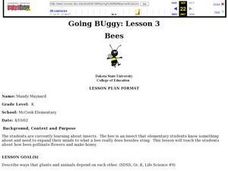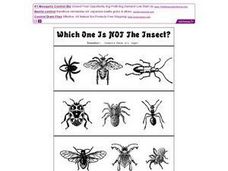Curated OER
Are You One Of Us?
Students discover how to classify things based on their similarities and differences. Students give the characteristics of insects and create a classification list. Given examples of various types of insects, students classify them...
Curated OER
A Day in the life of...
Young scholars read about and study insects--their distinguishing characteristics, habitats, camouflage methods, defense mechanisms, etc. They draw pictures and write a story from the viewpoint of an insect and share their pictures and...
Curated OER
Are You One of Us?
Learners compare and contrast insects and arthropods, identifying characteristics of each. In groups, they sort pictures of arthropods into the five different classes of arthropods. They also sort pictures into insect and non-insect piles.
Curated OER
Word Search: Insects
In this word search worksheet, students locate fifteen words related to insects. Words include beehive, ant, wasp, spider, and ladybug.
Curated OER
Going Buggy: Lesson 3: Bees
Students review the characteristics of insects they have already been introduced to. As a class, they are introduced to the characteristics of bees and what it can do instead of sting. To end the lesson, they discuss how plants and...
Curated OER
'Don't Let the Bugs Bite' Challenge
In this insect facts learning exercise, students respond to 11 multiple choice questions that require them to exhibit what they know about insects.
K5 Learning
The Life Cycle
Studying plant, animal, or insect life cycles? Pair a science unit with a reading comprehension worksheet on life cycles. The passage touches briefly on butterfly, plant, frog, and dog life cycles before prompting readers to answer six...
Primary Resources
Science - The Parts of a Flower
Here is what a PowerPoint presentation should look like! This excellent show lets students know what they will be learning about, takes them through nicely-designed examples, leaves room for discussion questions, has a built-in activity,...
Curated OER
Missing Macroinvertebrates - Stream Side Science
Field study groups collect samples of stream water and identify the macroinvertebrates found. Using their data, they calculate a water quality index to rate the health of the stream. They graph their data and discuss the value of a water...
California Academy of Science
Composting: A Scientific Investigation: California Academy of Sciences
Garbage, recycle, compost: Does it really matter where we put our trash once we are done? By making detailed observations over seven weeks, kids will see which materials break down naturally to become a healthy part of the soil, and...
LABScI
Surface Tension: Liquids Stick Together
Use science to help you walk on water! Young scientists explore the properties of liquids including cohesion, adhesion, and surface tension. They use graphs to compare different liquids and make predictions about their molecular attraction.
Royal Society of Chemistry
Computational Chemistry—Chemistry Now
Can some plants make their own animal repellents? Science sleuths examine the properties of cinnamamide in pear trees using an case study about computational chemistry. The resource discusses how vital computers are to research, how...
Curated OER
Diversity in Insects
Second graders examine bug photos from across the world. In this biodiversity lesson, students use a field notebook to make observation of insect photos. The class gather on the floor to investigate a mock field of insects and share...
Curated OER
The Insect world
Students read about insects in pairs and answer questions based on their reading. For this insect lesson, students understand the parts of an insect and complete a worksheet. Students complete a list of insects letters a-z.
Curated OER
Insect Challenge Project
In this biology instructional activity, students identify insects by their name and write it in the correct box on the sheet. Then they catch insects with nets and bring them in to identify. Students also earn points for the number of...
Curated OER
The Insect Files
Students are provided with a physical description of the insect, in words and graphics, including body parts, special adaptations, color, and so on. They explore and report on all four elements of an insect's habitat: food, water,...
Curated OER
Quiz on Insect Anatomy
In this insect anatomy quiz worksheet, students complete an on-line quiz, clicking on question and answer cards to complete and scoring 1 point per correct answer.
Curated OER
Parts of an Insect
In this science instructional activity, students read about the three parts of an insect. Students also analyze a labeled picture of an insect that shows its mouth, antenna, head, led, thorax, and abdomen.
Curated OER
Which One is not the Insect
In this which one is not the insect worksheet, students look at three lines of bugs and circle the one on each line that is not an insect. Students then color each insect or bug with appropriate colors.
Curated OER
Insects and Creepy Crawlies Word Search
In this science worksheet, students look for the names of the insects that are found in the word search puzzle. There is special attention to the spelling.
Curated OER
Insect Body Parts and their Functions
Learners explore all the parts of an insects body and assess their specific functions. They review an extensive vocabulary list of terms and then relate the parts of an insect to those of a human being. Dragonfly Poetry is also taught...
Curated OER
It's (Not) Just a Bug: Simulating Invasive Insect Predation on a Plant Population
Students reflect on challenges that face farmers in cultivating crops, including insects. They then simulate how crops are affected by native and non-native insect populations and the options farmers have to protect their crops. Finally,...
Curated OER
Insect Travel Brochure
Seventh graders explain what a trophic level is and how different organisms fit into different trophic levels. They observes different insect habitats and find reasons for why some habitats may be better suited for insects, than other...
Curated OER
Insect Anatomy
In this insect activity, students label the parts of an insect on a diagram and then write down one fact about each of the body parts. This activity has 5 fill in the blank and 6 short answer questions.
Other popular searches
- K 2 Life Science Insects
- Science Insects
- Parts of Insects Science
- Life Science Insects
- Science Spiders vs Insects
- Esl Lessons Science Insects
- Esl Science Insects

























